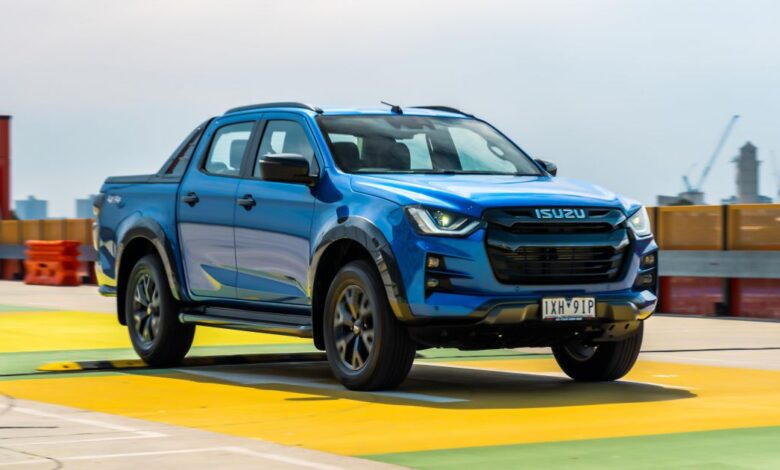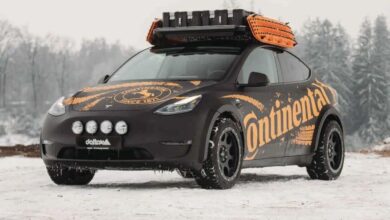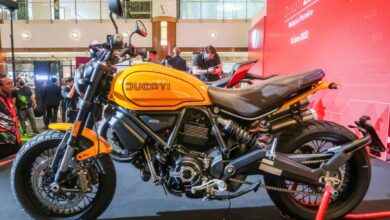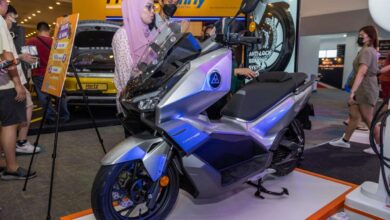2023 Isuzu D-Max X-Terrain review

The Isuzu D-Max is well-and-truly ensconced as Australia’s third top-selling dual cab these days, behind only the Toyota HiLux and Ford Ranger.
Much of this demand is for the range-topping D-Max X-Terrain, which competes with the Ranger Wildtrak and HiLux SR5.
This is a variant with leather seats, all the interior mod-cons, plastic wheel arch flares, and a style-led plastic aero sailplane. In other words, it’s not designed for a mine or building site.
But for those who want a dual-cab workhorse that doubles as a second family car, it offers plenty.
While the 2023 model brings minor tweaks detailed here, this model is still in the early phase of its life cycle.
How much does the Isuzu D-Max X-Terrain cost?
This is Isuzu’s top-of-the-tree variant, with a list price of $67,500 before on-road costs.
However that’s largely irrelevant, since Isuzu is offering a national drive-away price of $64,990 at the time of writing.
Flashy paint such as our car’s Neptune Blue Mica paint adds $650.
For some context here’s a list of advertised drive-away prices for key competitors, all in equivalent high-grade spec variants.
There are no current national offers for many competitor utes, so we entered the postcode of 3000 (Melbourne) into each brand’s pricing guide. Prices can vary by as much as $3000 in different parts of the country.
- Isuzu D-Max X-Terrain auto: $64,990
- Ford Ranger Wildtrak auto: ~$73,000
- Toyota HiLux SR5 auto: ~$66,500
- Mazda BT-50 SP: ~$73,000
Keep in mind that there are D-Max X-Terrain shortages and subsequent wait times should be expected – the current average is about 140 days.
This means there are a lot of landed D-Maxes in the classifieds being sold at a substantial mark-up.
What is the Isuzu D-Max X-Terrain like on the inside?
The D-Max X-Terrain has a proximity-sensing key fob for your pocket which unlocks the car when you grab the handle, and locks the vehicle when you walk away.
The front seats are just great, with prominent bolstering for the side and thigh, decent quality leather, heating, red stitching, and powered adjustment including lumbar for the driver. They’re the most comfortable seat in any diesel ute on sale (alongside its BT-50 twin).
The steering wheel is likewise trimmed in soft-feeling leather trim, and it adjusts for both rake and reach unlike the old model. Buttons for audio and phone controls are on the left spoke, and buttons for driver assist and trip computer controls on the right.
It also has a button on the right spoke which, when pressed for three seconds, disengages the lane-keeping assist system that re-activates each time the vehicle is turned on. This is better than the older model which forced you to dig through the instrument menus.
The instrument panel uses traditional analogue speed and rev gauges unlike the all-digital Ranger, with a small screen in between that shows vehicle speed, active safety settings, trip data, fuel efficiency etc. While small, it has legible graphics.
The dash is padded and has red contrast stitching, plus a nifty lidded console above the touchscreen. Below this runs a stylised piano black plastic trim insert, which carries over to the gearstick and screen surrounds – and is a bit of a dust- and glare magnet.
There’s a heap of storage including two gloveboxes, high-mounted cup holders below each outboard vent, big bottle holders in each door, and a central tunnel with an open phone cubby, cupholders, and a lidded centre console.
In terms of build quality, there were no squeaks or rattles and everything felt well put-together, if built to a price: meaning lots of hard scratchy plastic trims which in all fairness are probably easier to keep clean.
The 9.0-inch centre touchscreen takes up plenty of real estate and sits nicely in the driver’s eye line. It has satellite-navigation, a reversing camera with an okay view of the tow ball (surely a 360-degree camera should be fitted though, given it comes in a much cheaper GWM), a good sound system including roof speakers, and wireless Apple CarPlay and Android Auto.
Yet at the same time it feels like an afterthought rather than a fully integrated screen, since it controls no vehicle functions beyond multimedia, and it’s not overly quick. There is also just the one USB-A plug up front, plus a 12V point for an adapter.
There is one rather bewildering issue. Namely, every time you pull down or put up the sun visor, it knocks the rear-view mirror out of position. How did something this basic get through all those engineers and designers? And how wasn’t it addressed in the latest update? Baffling.
The dual-zone climate controls are run by handy rocker switches that correspond to a small digital readout, below which sits a dial to select high- and low-range four-wheel drive. No naff touchscreen controls for air-conditioning here…
The back seats are pretty roomy, with my 194cm frame able to fit (just) behind my own driving position. Rear occupants get their own air vents, one USB point, map holders in the seat backs, a bag hook on the back of the passenger seat, a pull-down centre armrest with cup holders, and bottle holders in the doors. There are also sturdy grab handles on each B-pillar.
The seat bases (60 per cent on the right and 40 per cent on the left) flip upwards to create more storage, and cover two lidded floor cubbies. The seat-back pulls downwards to reveal the child-seat top-tether anchor points which are paired with two ISOFIX anchors.
One handy addition is the soft-closing tailgate, which uses pneumatic tubes on each side like a fly screen door.
The factory fitted bedliner sits below the rails and is of high quality, while the X-Terrain also comes standard with hard sliding roller tonneau cover/shutter – just be aware that it robs you of space up the front of the tub. It’s manually operated and lockable, rather than powered like a Wildtrak’s.
I could easily go without some of the cosmetic features such as the glossy grey plastic aero piece behind the rear window, which is all form and no function. But hey, maybe you like the look…
What’s under the bonnet?
Isuzu’s 3.0-litre four-cylinder turbo-diesel produces middling outputs of 140kW (at 3600rpm) and 450Nm (at 1600-2600rpm).
It’s mated to a six-speed Aisin automatic transmission and a part-time 4×4 system with low-range.
Fuel consumption under ADR testing is rated as 8.0 litres per 100km on the combined cycle, and the fuel tank stores 76L of diesel.
Braked-trailer towing capacity is 3500kg with a 350kg download (using Isuzu’s tow kit accessory).
We returned a 0-100km/h time of 11.3 seconds on a VBox – one-tenth slower than a HiLux managed on the same surface in the same weather. Keep in mind our test vehicle had very low mileage.
How does the Isuzu D-Max X-Terrain drive?
The 3.0-litre diesel doesn’t lead the segment when it comes to refinement, although it’s certainly not as coarse or clattery as the engines used in older-generation D-Maxes were.
While its outputs of 140kW and 450Nm aren’t massive on paper, it’s certainly punchier by the seat of the pants than one rival with the same on-paper outputs: the Nissan Navara.
Indeed it’s a match for the 150kW and 500Nm 2.8-litre Toyota HiLux with a VBox, if not Ford’s benchmark V6 Ranger, when it comes to punch off the mark and rolling acceleration.
It never feels slow and will even chirp the rear tyres at times when unladen. In fact it gets up and goes much more quickly than it really has any right to, from the seat of the pants.
While the Aisin transmission only has six gears, they’re well-spaced and the driveline creates good speed-retaining downhill engine-braking by dropping a cog with decisiveness.
Two additions that might be handy are paddle shifters for towing, and a stop/start system for urban commuting. Both are missing features.
It’s also very efficient. Over a few hundred kilometres of driving on both highways and over suburban roads it averaged 8.5L/100km, while over the whole life of the vehicle in various hands it had averaged 9.6L/100km including mischievous journos from other titles.
One function it does lack is full-time 4WD, instead running as a rear-wheel drive on tarmac and offering low- and high-range (50:50) 4×4 driving modes in the rough stuff, with a rear locking diff to help out over rugged terrain.
It’s quite capable off the beaten path from a mechanical perspective, though our test vehicle’s road-biased highway tyres lack grip, and the traction control system takes too long to activate if you’re running the vehicle in rear-wheel drive. More rapid response please…
Dynamically it’s pretty well sorted without a load, ironing out road and gravel imperfections nicely with good noise suppression, and a relatively settled rear end with only mildly annoying pogo-ing over corrugations. That said, the Ford Ranger is plusher over a B-road.
Another great feature is its electric power steering, which is feather-light and makes the D-Max feel very wieldy around town in daily driving.
During my time with the car I also did about 300km towing a car trailer maxing out when laden at around 2000kg. The tow bar was easy to line up solo with the camera view, and the mirrors proved sufficiently large to keep the wide wheels in the lane.
What was more impressive was the performance: aside from some mild shunting under brakes it was hard to notice the trailer was even there, and my fuel economy after the 150km laden return from Gippsland was 11.6L/100km – really quite good for a towing test.
The driver assist features for the most part worked well – meaning the adaptive cruise control and blind-spot monitoring (which automatically turns off when the trailer brakes and lights are connected).
The camera-based lane-keeping aids are okay if not class-leading, though I tended to keep them off via a single button-push when outside the city limits with their well-painted lines.
There’s also a speed limit readout which chimes if you exceed the posted limit. You can numb its sensitivity setting to engage at 10km/h over, or shut it off altogether. And it stays off once set that way.
Tech specs
- Power: 140kW
- Torque: 450Nm
- Transmission: 6-speed auto
- Fuel economy: 8.0L/100km
- Drive type: Part-time 4×4 (2H, 4H, 4L)
- Maximum towing: 3500kg braked
- Kerb weight: 2175kg
- Payload: 925kg
- Gross vehicle mass: 3100kg
- Gross combination mass: 6000kg
- Power steering type: Electric
- Turning circle: 12.5m
- Ground clearance: 240mm
What do you get?
This flagship variant comes equipped with everything that Isuzu Ute has to offer.
- 18-inch alloy wheels
- 265/60 Bridgestone Dueler highway tyres
- Full-size steel spare wheel
- Proximity key and walk-away lock
- Bi-LED headlights, auto-levelling
- LED daytime running lights
- LED rear combination lights
- Auto headlights with dusk sensors
- Auto windscreen wipers
- Heated side mirrors
- Front parking sensors
- Rear parking sensors
- Tailgate assist
- Factory fitted towbar receiver
- Tub liner
- Hard roller tonneau tub cover
- Roof rails
- Leather-accented seats with red stitching
- Powered driver’s seat
- Heated front seats
- Leather-wrapped steering wheel
- Dual-zone climate control with rear vents
- Push-button and remote engine start
- Tyre-pressure monitor
- Auto-dimming rear-view mirror
- Eight-speaker sound system
- 9.0-inch touchscreen display
- Satellite-navigation
- Apple CarPlay
- Android Auto
- Reversing camera
For a full spec walk across all D-Max variants, read our 2023 price and specs story here.
Colours
The 2023 D-Max range is available in the following colours, with all but Mineral White incurring a $650 premium:
- Mineral White
- Basalt Black mica
- Neptune Blue mica
- Mercury Silver metallic
- Obsidian Grey mica
- Granite Grey metallic (X-Terrain exclusive)
- Moonstone White Pearl (LS-U, LS-U+ and X-Terrain only)
- Magnetic Red mica (LS-U, LS-U+ and X-Terrain only)
- Volcanic Amber metallic (X-Terrain exclusive)
Is the Isuzu D-Max X-Terrain safe?
Australian crash testing authority ANCAP just re-tested the D-Max and MU-X SUV, again awarding them a five-star safety rating against outgoing 2020-2022 protocols.
Models built from July 2022 received a design change to the driver’s knee airbag and instrument panel.
Standard safety features include:
- 8 airbags
- Rear-seat ISOFIX and top tethers
- AEB with Turn Assist
- Forward Collision Warning
- Adaptive Cruise Control
- Traffic Sign Recognition
- Lane Departure Warning
- Lane Departure Prevention
- Lane Keeping Assist
- Emergency Lane Keeping
- Blind Spot Monitoring
- Rear Cross Traffic Alert
- Trailer Sway Control
The D-Max now automatically disables Blind Spot Monitoring and Rear Cross Traffic Alert when a trailer is hitched and detected via the genuine trailer wiring harness.
This update comes just a year after Isuzu introduced the Lane Support System switch that allows the driver to switch lane keeping functions on or off, at the singular push of a button.
Isuzu D-Max X-Terrain cost to run?
Isuzu Ute Australia provides a six-year, 150,000km warranty with seven years of roadside assist and capped-price servicing
2023 Isuzu D-Max service pricing
- 3-month inspection: Free
- 12 months or 15,000km: $435
- 24 months or 30,000km: $445
- 36 months or 45,000km: $665
- 48 months or 60,000km: $555
- 60 months or 75,000km: $335
- 72 months or 90,000km: $799
- 84 months or 105,000km: $455
CarExpert’s Take
The D-Max isn’t a total bargain, but in the context of its segment the drive-away price point for the X-Terrain is reasonable.
It offers great seats, a comfortable interior with ample storage, and a relatively comfortable ride. And while it lacks the Ranger’s knockout diesel V6 and full-time four-wheel drive, it still offers lively performance, and as we found is a super-efficient tow vehicle.
There’s also the long warranty and roadside assist coverage and reasonable capped servicing prices, and what has proven to be good resale values due to a reputation for longevity.
I don’t consider it quite the class leader (our recent ute mega test gave the gong to the Ford, and its Volkswagen Amarok twin is now launching too), but it deserves to be among the top sellers.
As ever, shortlist it if you want an unpretentious workhorse with just enough luxury to serve as a family hauler when needed.



















